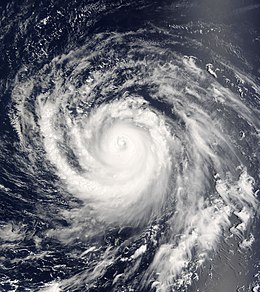Typhoon Songda (2004)
| Typhoon (JMA scale) | |
|---|---|
| Category 4 (Saffir–Simpson scale) | |

Satellite image of Songda on September 1
|
|
| Formed | August 26, 2004 |
| Dissipated | After September 13, 2004 |
| (Extratropical after September 8, 2004) | |
| Highest winds |
10-minute sustained: 175 km/h (110 mph) 1-minute sustained: 230 km/h (145 mph) |
| Lowest pressure | 925 hPa (mbar); 27.32 inHg |
| Fatalities | 28 total |
| Damage | $9 billion (2004 USD) |
| Areas affected | Japan |
| Part of the 2004 Pacific typhoon season | |
Typhoon Songda was the second-costliest typhoon on record. The 18th named storm of the 2004 Pacific typhoon season, Songda developed on August 26 near the Marshall Islands. Following a path that Typhoon Chaba took nine days prior, Songda moved west-northwestward and strengthened quickly amid favorable conditions.
Forming in a similar region as Typhoon Chaba did nine days earlier, Typhoon Songda originated on August 26 from an area of convection, or thunderstorms, east-northeast of Kwajalein in the Marshall Islands. At 06:00 UTC that day, the Japan Meteorological Agency (JMA) assessed that a tropical depression developed. The convection steadily organized and consolidated into rainbands around a well-developed circulation, aided by low wind shear. At 11:30 UTC on August 28, the Joint Typhoon Warning Center issued a tropical cyclone formation alert, and just 30 minutes later upgraded the system to Tropical Depression 22W.
Favorable conditions allowed the nascent system to quickly intensify. At 00:00 UTC on August 28, the JMA upgraded the depression to a tropical storm,naming it Songda. Moving west-northwestward around the subtropical ridge to the north, the storm passed north of the Marshall Islands. An eye began becoming visible on satellite imagery on August 29, prompting the JTWC to upgrade Songda to typhoon status at 12:00 UTC that day. A day later, the JMA also upgraded the storm to typhoon status, and the agency estimated an initial peak intensity on August 31 of 165 km/h (105 mph). That day, the JTWC also estimated peak 1 minute winds of 230 km/h (145 mph), equivalent to a Category 4 on the Saffir-Simpson scale. Operationally, the JTWC estimated slightly higher winds and assessed Songda as a "super typhoon", but it was revised downward.
...
Wikipedia
